Overview
Most sailors own sloop rigged sailboats. A sloop is a sailboat with a sail in front of the mast (jib sail) and a sail behind the mast (mainsail). The air leaving the jib moves over the mainsail with more velocity because of its location in front of the mainsail. We squeeze the air between the two sails (by trimming the sails) and that increases the air speed over the mainsail. 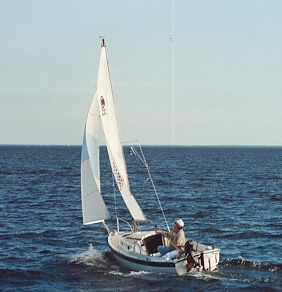 The sloop sail configuration makes sloop-rigged sailboats more powerful than they would be with some other type of rig. That's why most contemporary sailboats are sloops.
The sloop sail configuration makes sloop-rigged sailboats more powerful than they would be with some other type of rig. That's why most contemporary sailboats are sloops.
We can think of sails as objects that create lift or sail power. We use the word lift to identify a force that can moves us and our boat through the water in almost any direction. Lift is defined as a differential pressure between two sides of an object. It can apply to hulls and rudders as well as sails. The reason sailboats can sail into the wind is that they can produce lift on that point of sail.
The other fundamental principal involved in sailing is drag. Every vehicle must overcome various forms of drag before it can move. You canít see drag in most cases, but it is the opposite of lift and must be understood and identified by sailors. Gravity, water conditions and many other factors create drag on sailboats. We are considered good sailors when we analyze the lift and drag relationship and come up with the right sail configuration for our sailboat.
Selecting the right sail shape for different wind conditions can be complicated for the novice sailor. The good news is that it's very simple once you understand the basic fundamentals. Your success as a sailor depends on good sails. Sail makers are talented individuals that can make quality sails that make your sailboat sail well with your help. No one can sail well with bad sails.
How well we sail is a balancing act between our boat and the existing wind conditions. Our goal is to get where we are going in a safe and timely manner and look like we know what we are doing. We are going to be able to see the wind and analyze how the wind effects our boat as we gain experience. We are going to feel like we have complete control of our sailboat as we gain our sailing experience.
Sail Power
Sails are really stretchable adjustable airfoils. They do the same thing that wings do on airplanes, but at a much slower speed. Maximum lift is generated at the maximum camber point on the sail. We can see that point if we view pictures of sailboats sailing. We just need to know where to look. 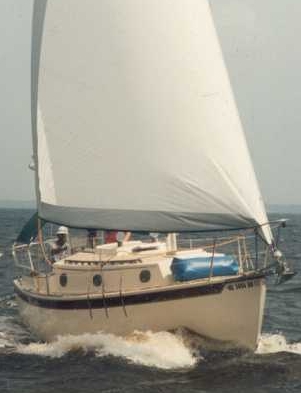 Start at the head of the sail and work your way down to the foot. Maximum curvature on a main sail should be at the 50% point front to back. The jib should be at the 33% point front to back. If we look at our sails while we are sailing, we will see that our sailcloth is tight and void of wrinkles along a vertical line in both the jib and the main. The sailcloth in front and behind the maximum camber point will have wrinkles. The camber points may vary in position from boat to boat, but the principle is the same for all sailboats. See where the wrinkles stop and the power starts on the jib on the left.
Start at the head of the sail and work your way down to the foot. Maximum curvature on a main sail should be at the 50% point front to back. The jib should be at the 33% point front to back. If we look at our sails while we are sailing, we will see that our sailcloth is tight and void of wrinkles along a vertical line in both the jib and the main. The sailcloth in front and behind the maximum camber point will have wrinkles. The camber points may vary in position from boat to boat, but the principle is the same for all sailboats. See where the wrinkles stop and the power starts on the jib on the left.
The trailing edge of the mainsail and jib sail (leech) will twist off at the top. This twist is designed and programmed into the sail for a very important reason. The air moving across the sail at the top of sail is not moving in the same direction as the air moving across the bottom of the sail. This difference in direction is caused by the drag created by the waterís surface. The air moves in a different direction between the top and bottom of the mast because of surface drag. Sail twist is an important trim feature that is built into your sails by your sail maker.
An example of the relationship between lift and drag is that we could have too much sail surface drag to move a boat in calm conditions. By replacing our large headsail with a smaller headsail, we could reduce sail surface drag to a point that our boat might be able move in those conditions. Increasing lift in some conditions may not be possible, but reducing drag may be an option. Sailing is always a battle between lift and drag and how well we analyze the relationship between the two.
We now have the sail conditions that are typical for static sail shape on an average sailboat. The chamber and the twist are correct for both sails. 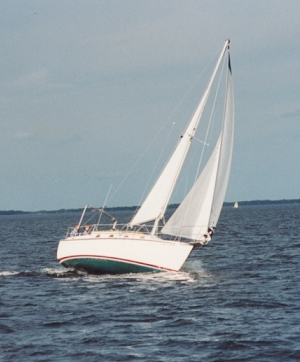 We adjust the angle of attack of the jib with the sheets to achieve the proper trim on that point of sail for the course we have selected. While maintaining course, we let the sheets out a little until the jib starts to luff (shake or flutter). Sheet in the jib until the jib stops luffing while maintaining your course. Adjust the main sail in the same fashion. Repeat the trim adjustments for every course change making sure you adjust the jib first and main second.
We adjust the angle of attack of the jib with the sheets to achieve the proper trim on that point of sail for the course we have selected. While maintaining course, we let the sheets out a little until the jib starts to luff (shake or flutter). Sheet in the jib until the jib stops luffing while maintaining your course. Adjust the main sail in the same fashion. Repeat the trim adjustments for every course change making sure you adjust the jib first and main second.
The dynamics of sailing is controlled by sailor input and is similar to a person driving an automobile. The gear selection in an automobile is similar to the amount of sail luff stretch on a sailboat. An automobile's steering wheel and the tiller and sheets perform essentially the same direction control function on a sailboat. Different conditions require changes to these fundamental controls by the operator in both vehicles. Learn the fundamentals of sailing and then practice as often as possible and sailing will be easy.
Maintaining your course and doing your sail trimming at the same time will be difficult at first. This will become less difficult with practice. This is similar to shifting gears and steering a car at the same time. Steering a boat is similar to steering a car. You need to pick out a terrain feature on a shoreline to act as a guide. Look at that spot for course corrections.
If the wind was always the same strength and we followed the basic instructions above, learning to sail would be quick and easy. Wind strength does change and that means that we have to do something to maintain our boat's balance in different wind conditions. Let's talk about what kind of sail shape and size is desirable at different wind strengths. These conditions are going to apply to keel boat with 40% of their total weight in the keel and a moderate sail plan. Normal sailing with both sails is possible up to 18 knots of wind. Some reduction in sail area and power is desirable above that wind speed. You should consider a lower wind speed as a reference if your boat has more sail area and less ballast. All sailors should identify a conformable maximum wind speed for their boats with full sails. When we talk sailing, we normally talk about getting the most performance that's possible from our boats. This is not the case when we have winds above that critical point. That's when we start reducing sail performance to match our wind and weather conditions. Most of our sailing will be in the "I want more performance" range and that's what we need to practice and that's what we need to talk about in sailing school. We will spend some time in the heavy wind category later.
The performance range of sailing should be divided into three categories. We have slow, medium and fast wind conditions. Using the parameters above, 0 to 5 knots of wind could be considered slow wind. 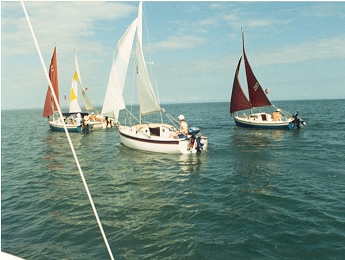 The water will be slick or dark in patches. 6 to 10 knots of wind are medium wind and the water is dark all over. Using the typical boat above, 11 to 18 knots of wind is considered fast wind and the water has one white cap now then at 11 and white caps everywhere above 12 knots.
The water will be slick or dark in patches. 6 to 10 knots of wind are medium wind and the water is dark all over. Using the typical boat above, 11 to 18 knots of wind is considered fast wind and the water has one white cap now then at 11 and white caps everywhere above 12 knots.
We need to change our boat's trim condition for the current wind strength. Sails need maximum chamber and minimum luff stretch in light wind conditions and sails need minimum chamber and maximum stretch in heavy wind conditions. A sailís luff is the leading ledge of a sail and thatís the part of the sail that we stretch. Sailcloth can be stretched and shaped for extreme conditions. A sailor needs to know the maximum luff stretch thatís available on his or her boat. A sailboat needs less lift in fast wind and more lift in light conditions. The stretch moves the chamber and changes the amount of chamber at the same time. Your sail maker is responsible for building this capability into your sails. No one can sail up wind with poorly constructed sails. Most sailors mark their mast with a pencil at the maximum sail stretch point.
We have determined the current wind strength and made a decision about our initial trim adjustments. Let's say the wind is blowing at 12 knots, white caps are everywhere and we are setting up our boat at the dock. We will insure that the mailsail out-haul on the boom is at it's maximum stretch position. Hoist the main sail and increase the luff stretch to its maximum position. Leave the dock under sail and then raise the jib. Increase the jib luff stretch to its maximum position. The sail chamber on both sails will be at its minimum or we sometimes say the sails are trimmed flat. The way we know that our adjustments are correct is to insure that the sails are smooth without the tell-tail "S" curve behind the luff. Sailing away from the dock is appropriate in some conditions and not in others. Always consider safety as your first requirement when sailing away from the dock. Your initial adjustments should change as wind conditions change. Make your sail adjustments on the water when the wind conditions change between the three groups in the performance range. Look at the water's surface for your wind speed changes.
Comfortable points of sail in 12 knots of wind for pleasure sailing are close, beam and broad reaches. Downwind sailing should be avoided because an accidental jibe at this wind strength could cause damage. Changing directions can be accomplished by tacking into the wind and changing directions going downwind should be avoided if possible. A tell-tail sign for 18 knots of wind is the tops of the white caps being blown off. This range of wind speed between white caps everywhere and the tops being blown off is where we should consider reducing our sail area.
Heavy air sailing above 18 knots on a close hauled course is easy sailing if you have the right amount of reduced sail area. Substantial winds in the 40 knot plus range can be handle by our example boat with a jib sail and two reefs in the mainsail. We gently round up into the wind when we want less power in a gust. We keep a reference point on the horizon and the bow of the boat to measure our angle of heel. When we exceed our normal angle of heel, we point up to reduce heel and power.
Heeling on other points of sails in heavy air is not a problem. Sailing downwind should be avoided because of the possible danger from an accidental jibe. Board and beam reaches are the best points of sail with a sail area that is acceptable for a close reach. Board and beam reaches will cause minimal heel angles. Changing directions always involves a tack. Never jibe in that much wind.
Sail Trim
We are going to leave the power portion of sailing for the time being and look at the sail trim elements of sailing. Sail power and trim adjustments need to be performed at the same time but should be analyzed separately. On the wind sailing is the most fun and is the most interesting. All points of sail need to be mastered and practiced by sailors and we will cover them individually. On the windsailing is where we create the most lift from the sails, hull, rudder and keel. Lift is the difference in pressure between the sides of an object. We as sailors need to know when we have lift and how it was created. Different sailboats create lift at different wind strengths and are really designed for specific conditions. Heavy boats with a moderate sail area like heavy wind areas. Light boats with lots and lots of sail area likes light wind areas.
We adjust our jib or headsail first. This sail is in free air on a sloop. The main sail is behind the mast and the mast distorts some of the air on the main. Steer the boat to 45-degree angle to the waves. Trim the jib to a close haul position by bringing it in as close to the centerline of the boat as possible. 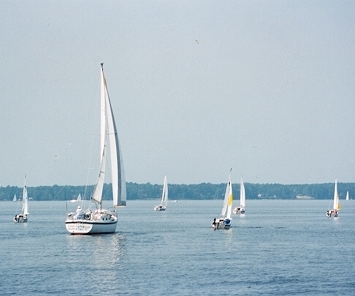 Maintain the twist at the top of the sail by adjusting the sheet angle at the deck. Avoid pulling the sail twist out of the sail. Look for the trim point that has a luff (shake) at one point and none just a little inside that position. Adjust the main sail close to the center of the boat and let it out until luffs (shake). Adjust the main just inside that luff position. Both sails may luff at the top of the sail. During this trim adjustment, the course of the boat must be maintained. When youíre finished with your adjustments, you can maintain that trim with the tiller from that point forward on that tack. The wind is constantly changing and no one except a race boat with substantial crew can perform the initial trim adjustment continually. As recreational sailors, we sail the wind and not the course. This gives us the ability to see the wind changes as they occur. Most of these changes are caused by the terrain and how the wind moves around different landmasses. Advanced inland sailing includes a study in how wind direction is effected by terrain.
Maintain the twist at the top of the sail by adjusting the sheet angle at the deck. Avoid pulling the sail twist out of the sail. Look for the trim point that has a luff (shake) at one point and none just a little inside that position. Adjust the main sail close to the center of the boat and let it out until luffs (shake). Adjust the main just inside that luff position. Both sails may luff at the top of the sail. During this trim adjustment, the course of the boat must be maintained. When youíre finished with your adjustments, you can maintain that trim with the tiller from that point forward on that tack. The wind is constantly changing and no one except a race boat with substantial crew can perform the initial trim adjustment continually. As recreational sailors, we sail the wind and not the course. This gives us the ability to see the wind changes as they occur. Most of these changes are caused by the terrain and how the wind moves around different landmasses. Advanced inland sailing includes a study in how wind direction is effected by terrain.
Sail trim adjustment on other points of sail are different in that the sail's angle of attack must change with a change in the boat's course. If the wind direction remains the same and your sailboat changes direction, you need adjust your jib first and then the main sail second just like you did when the boat was on a close reach. The sails must address the wind in the same manner. If the boat changed direction to a beam reach, the jib is let out to a point that the jib luffs and in again until it just stops. Some twist will be lost during this adjustment. You need to check to made sure it not critical. Adjust the main sail the same way. The reason we are adjusting the jib first the main second is because the main sail is using the air off the jib for its wind source. The direction of the wind off the jib will determine main sail trim. The relative wind strength has been reduced on a beam reach. If youíre going to be on this tack for a long period of time, you may need to adjust the power settings for the sails. A change to broad reach course follows the same procedure. More twist will be lost as the sails move outward away from the centerline. It's important on a broad reach to maintain lift in the sails by insuring that the boats course will support the transfer of air between the jib and the main. It's rare to see a situation where conventional sails would support lift on a downwind course. Recreational sailing downwind is the sails being perpendicular to the wind with the maximum sail area possible.
A little luff in the twist area of the mainsail is much better than stalling the sail in that area. Power from the upper mainsail area is lost if that area is stalled. The stalled twist area of a mainsail can cause additional boat heel in substantial wind. Boats normally sail better with a minimum amount of heel.
We can see that understanding sail shape is really pretty simple. Moving the boat around a stationary trim point with the tiller takes some understanding and practice. We really use our eyes; ears and the boat's angle of heel to determine trim points. If you can rub your stomach and pat your head at the same time, you can sail a sailboat. If you can't rub and pat, then you will need to do one at a time.
Maneuvering
Now that we know about sail power and trim, its time to learn about maneuvering your boat while sailing. The tack is the basic change of course from one direction to another. We use the same word to identify two different procedures. A tack can be a course that your sailboat sails and it can also be a maneuver that results in a direction change. In this case we are looking at the direction change maneuver. Lets say we are on a close hauled course and we are going to change direction. 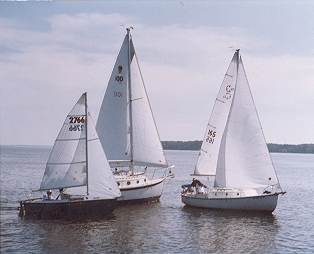 We should always come up to a close hauled position with maximum boat speed before we tack. The course that we are on is either a port tack or a starboard tack. If it's a port tack, the wind is coming over our port side and moving to our starboard side. If it's a starboard tack, the wind in coming over our starboard side and moving to our port side. In this case, we are on a starboard tack and preparing to tack to a port tack. We trim our boat for maximum speed and get as close to the wind as possible. We are not going to have any sail power during the 90 degrees to takes to make our course change. We look for a point of land or a stationary object that's 90 degrees off the port bow. That object will be an aiming point once we start the tack. Start the turn with the tiller and maintain your jib sail trim until the jib starts to luff. The main sail on a sloop is self-tending and will not need adjustment during the tack. The jib sheets can be changed to the port tack and trimmed after the boat on its new heading. That heading should be a little more than 90 degrees because of the speed slow down during the tack. The course can be higher to windward after the speed comes back on the new tack. Optimal rudder movement during the tack will change with different boats, boat speed and wind speed. Practice is the only solution.
We should always come up to a close hauled position with maximum boat speed before we tack. The course that we are on is either a port tack or a starboard tack. If it's a port tack, the wind is coming over our port side and moving to our starboard side. If it's a starboard tack, the wind in coming over our starboard side and moving to our port side. In this case, we are on a starboard tack and preparing to tack to a port tack. We trim our boat for maximum speed and get as close to the wind as possible. We are not going to have any sail power during the 90 degrees to takes to make our course change. We look for a point of land or a stationary object that's 90 degrees off the port bow. That object will be an aiming point once we start the tack. Start the turn with the tiller and maintain your jib sail trim until the jib starts to luff. The main sail on a sloop is self-tending and will not need adjustment during the tack. The jib sheets can be changed to the port tack and trimmed after the boat on its new heading. That heading should be a little more than 90 degrees because of the speed slow down during the tack. The course can be higher to windward after the speed comes back on the new tack. Optimal rudder movement during the tack will change with different boats, boat speed and wind speed. Practice is the only solution.
A sailing maneuver that's very important is pointing up in a gust of wind. The wind is always changing and our goal in this example is making as much progress to windward as possible without slowing down. All sailboats should point up in a gust of wind. When we sail into a gust going upwind, we should allow the boat to point up on it's own until we reach the same angle of heel that we had before the gust. We need to stop the movement upwind before the sails luff or before the boat slows down. The sequence of events is the gust hits the boat and the boat angle of heel increases. The boat's bow points up into the wind and then the boat angle of heel is reduced and the sails luff. We need to stop the maneuver just before the luff to take advantage of distance and speed make good to windward.
Another sailing maneuver is just the opposite in origin. When our sails luff because the wind changes direction in the opposite direction. We need to fall off to leeward to as soon as possible to reduce the effects of the luff and reduced power. Some sailors sail a course that resembles small "S" turns to test the luff and keep their boats at optimal course and trim positions. This may be too much work for most recreational sailors except when you really need to sail well for some reason.
We have worked through sail power, sail trim and several sailing maneuvers. The next important element of sailing is balance. The balance of a sailboat is how we measure sailing efficiency. We must understand sailboat balance if we are going to become good sailors. We have two sailing conditions called weather and lee helm.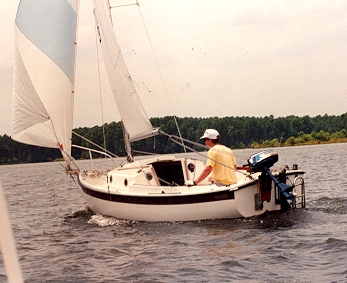 Both conditions indicate the boat is unbalanced to some degree. A desirable condition for most sailboats is a small amount of weather helm. Any time a sailboat is being driven by the wind on any point of sail, the boat can be unbalanced or moving through the water on a course with the rudder maintaining the course. Pressure on the rudder is required to maintain the sailboat's course. If you neutralize the tiller or rudder and the boat rounds up into the wind, the pressure on the rudder was weather helm. The boat has lee helm if the boat falls off the wind. A small amount of weather helm feels good to the person at the helm and adds a modest amount of safety. Boats that round up into the wind on there own will slow down and normally stay in the same general area. Boats with lee helm could sail off without the crew during an unexpected accident. The balance point of all sailboats is at the center of lateral resistance (CLR). The CLR has an equal amount of wetted surface on either end of the boat. When the boat makes a turn, the bow pushes water in one direction as the stern pushes the same amount of water in the opposite direction. This point of balance is the turning point on all sailboats. The CLR can move a little with heel but not much. All boats have sail power in front of and behind the CLR. If this power was perfectly balanced or equal, our boat would sail in a straight line without any pressure on the tiller. If our boat is well balanced and properly rigged, our boat should sail with minimum weather helm. If the wind increases while we are sailing and we do not adjust sail shape, the chamber on both sails will blow back in the sails and our sail power will be behind the CLR. Weather helm will increase substantially and the rudder will try to stop the boat. Forcing a sailboat to sail in an unbalanced condition with excessive weather helm produces undesirable drag and a slow boat.
Both conditions indicate the boat is unbalanced to some degree. A desirable condition for most sailboats is a small amount of weather helm. Any time a sailboat is being driven by the wind on any point of sail, the boat can be unbalanced or moving through the water on a course with the rudder maintaining the course. Pressure on the rudder is required to maintain the sailboat's course. If you neutralize the tiller or rudder and the boat rounds up into the wind, the pressure on the rudder was weather helm. The boat has lee helm if the boat falls off the wind. A small amount of weather helm feels good to the person at the helm and adds a modest amount of safety. Boats that round up into the wind on there own will slow down and normally stay in the same general area. Boats with lee helm could sail off without the crew during an unexpected accident. The balance point of all sailboats is at the center of lateral resistance (CLR). The CLR has an equal amount of wetted surface on either end of the boat. When the boat makes a turn, the bow pushes water in one direction as the stern pushes the same amount of water in the opposite direction. This point of balance is the turning point on all sailboats. The CLR can move a little with heel but not much. All boats have sail power in front of and behind the CLR. If this power was perfectly balanced or equal, our boat would sail in a straight line without any pressure on the tiller. If our boat is well balanced and properly rigged, our boat should sail with minimum weather helm. If the wind increases while we are sailing and we do not adjust sail shape, the chamber on both sails will blow back in the sails and our sail power will be behind the CLR. Weather helm will increase substantially and the rudder will try to stop the boat. Forcing a sailboat to sail in an unbalanced condition with excessive weather helm produces undesirable drag and a slow boat.
Your ability to sense your sailing conditions and take the right actions to balance your boat is what sailing is all about. Identifying all of these little sailing details comes with experience and is similar to learning how to drive a car. Sailing is more difficult in heavy wind conditions and on a light boat. Identifying the wind conditions for your area and the proper boat for your type of sailing is the key to sailing success and becoming a good sailor. You canít learn to sail some boats in some geographical areas. Generic sailboats for anywhere in the world do not exist. Picking a popular boat in your area is a good rule to follow for sailing success. The reason itís popular is because it works in that area.
 Click Image For The Sailboat Company's Home Page
Click Image For The Sailboat Company's Home Page